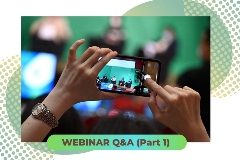Government officials will NEVER ask you to transfer money or disclose bank log-in details over a phone call. Call the 24/7 ScamShield helpline at 1799 if you are unsure if it is a scam.
In the Spotlight
Discover true stories of inspiration, inclusiveness and care
Share With Us!
Q&A from Be That Special Someone Today Webinar (Part 1): How can we foster a caring commuting culture?

Did you attend the Be That Special Someone Today Webinar on 15 December 2020? You can read a summary of it here, or watch the full recap video here.
If your question was not answered during the final Q&A segment, fret not! Here is part 1 of 2 of the panelists' answers to some questions during the session:
Q: How can we foster a caring commuting culture?
A: Fostering a caring commuting culture is a community effort and requires everyone working together and playing their part.
One can start off by building understanding and empathy between commuters and commuters with mobility and special needs.
From various findings, we found that most commuters are hesitant to render help due to their lack of knowledge and a fear of helping. Therefore, we can first take initiative to learn more about the various conditions of commuters with needs and how to render assistance.
Interested commuters can find more information on how to help commuters with special needs at the SG Enable website (www.sgenable.sg) or Caring SG Commuter Portal (www.caringcommuters.gov.sg)
Q: What are some active digital measurements we are using to enhance commute experiences for commuters with needs/ Is there initiative to enable visually impaired commuters in identifying bus numbers?
A: Technology plays a critical role in augmenting our service delivery, especially to our commuters in need.
For example, to assist commuters in identifying arriving bus services and their stops, especially elderly and commuters with visual impairment, the Passenger Information Display System (PIDS) has been installed on all new public buses since 2018. The PIDS consists of both external and on-board displays that provide route specific information, such as bus service number, destination and MRT/LRT transfer information. there are also on-board audio announcements to inform passengers of the next bus stop.
The MAVIS (Mobility Assistance for the Visually Impaired and Selected Users) mobile application trial that was launched in January 2019 was well-received by visually impaired commuters. Mavis provides assistive features and makes it easier for visually impaired and wheelchair users to use public buses.
Q: What are some initiatives done for commuters with mobility needs/ How can we identify people with hidden disabilities/ How is awareness raised for these initiatives?
A: Open strollers, wheelchairs and other Personal Mobility Aids (PMAs) such as mobility scooters for the elderly are allowed on board public buses and MRT/LRT trains. All public buses are wheelchair friendly; there is at least one barrier-free access route at all MRT and LRT stations, and all bus interchanges and nearly all bus shelters are barrier free. To make it even safer, wherever possible, there are rubber gap fillers between trains and platforms to reduce the risk of commuters in wheelchairs, PMAs or with strollers slipping into or getting caught in the gaps. We have also completed 50 pedestrian overhead bridges fitted with lifts that are in close proximity to major transport nodes and health institutions.
To enhance navigation, LTA launched a new signage system at the Thomson-East Coast Line which was opened in end Jan 2020. The use of colours, numbers and symbols enhances understanding, minimising language barriers or vision limitations. Technology will be leveraged to complement the signage system, by making signage elements accessible by third party information providers.
Besides the infrastructure improvements, we would also require a community effort to make the public transport inclusive. To remind us to give way to those in need, Priority Use signs were implemented at lifts, platform screen doors and designated queue zones at all MRT/LRT stations. This initiative aims to improve the ride experience for the elderly, less mobile and families travelling with young children. We have also trained station staff and service ambassadors to proactively offer assistance to commuters.
For commuters with less obvious disabilities or ad-hoc medical conditions (e.g. feeling giddy, recovering from a surgery etc), a sticker identifier “May I have a seat please” was piloted in Oct 2019 to help them alert fellow commuters that they need a seat on the public transport. Please feel free to approach the staff at the Passenger Service Centres to obtain a sticker identifier. However, please also understand that others in the seats may also need it.
We hope to raise awareness of these initiatives through campaigns such as the Graciousness campaign (e.g. Stand Up Stacey on the priority seats), and the Caring SG Commuters Campaign, comprising of a series of online activities including a video series and a webinar. For more information on the video series and the webinar, please visit https://www.caringcommuters.gov.sg/video
